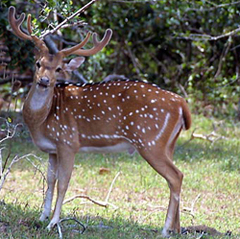Axis deer in Hawaii Island’s headlights
HAWAII ISLAND—The Department of Land and Natural Resources’ (DLNR) Division of Forestry and Wildlife (DOFAW) and a coalition of resource managers on Hawaii Island are still seeking information from island residents about the invasive axis deer.
Last week, DLNR announced that there were confirmed recent sightings of the introduced, damaging large mammal in areas of from Kohala, Kau, Kona and Mauna Kea.
“We are now expanding our surveys of areas where deer have been reported, and are developing a response and removal plan,” said DLNR Chairperson William J. Aila in a statement. “We consider this a serious problem with far-reaching economic and environmental impacts to the agriculture industry and native ecosystems on the island.”

A pineapple field eaten by deer.
Axis deer were first introduced to Molokai and Oahu in 1868, Lanai in 1920, and Maui in 1959. They were never historically introduced to the island of Hawaii, and their confirmed presence on that island has grave implications for island farmers and ranchers, public health, watersheds, and native Hawaiian ecosystems and species, State officials said.
A joint effort is now underway between DLNR, the Department of Agriculture, Big Island Invasive Species Committee (BIISC), federal natural resource management agencies, ranchers, farmers, private landowners and concerned citizens.
Strong, swift action is needed to protect Hawaii Island from newly introduced damaging ungulates that threaten the island’s environmental character, State officials said.

Deer prints in a pineapple field.
The BIISC is a voluntary partnership of private citizens, community organizations, businesses, land owners, and government agencies to address invasive species issues on the island of Hawaii. BIISC’s mission includes education, early detection, rapid response, control and eradication of invasive pests threatening agriculture, native ecosystems, industry, human health or the quality of life within Hawaii County.
The BIISC has heard from ranchers, land owners, and concerned residents from several locations on Hawaii island that they are seeing unusual game animals. BIISC is working with trackers and using game cameras to survey and confirm locations of these animals across the island from Kohala, Kau, Kona, and Mauna Kea.
“We take all of these reports very seriously since there are a number of mammal species present on neighboring islands that could do serious damage to agricultural industry on this island,” said Jan Schipper, BIISC program manager.
Efforts are currently in the information-gathering stage and Hawaii Island residents are being asked to document sightings or any damage they suspect might be from axis deer. BIISC said residents should call the invasive species hotline at (808) 961-3299, even if they are not sure if they have located an axis deer—specialists will be sent out to inspect the area.
“Ranchers and farmers have already expressed their concerns to me that deer and other species that are suspected to have been illicitly introduced on the ‘Big Island’ would destroy their crops and possibly introduce new diseases to our island, as has happened on other islands,” Schipper said.

Grape vine eaten by deer.
Besides agriculture and public safety concerns, conservation agencies are particularly concerned about the impact to forest and native ecosystems and threatened and endangered species. There are no fences on Hawaii Island that are tall enough to keep deer out. If deer become established, conservation and deer exclosure fences on the island will have to be raised to 8 feet.
DLNR estimated that retrofitting the more than 300 miles of fences could cost tens of millions of dollars. Farmers, ranchers and public safety officials would also need to install fences to protect crops and to reduce deer-vehicle collisions.
“DLNR’s mission is to preserve and protect our natural resources, paramount of which are our watersheds and native ecosystems. We will need to take quick and effective action to prevent costly and destructive impacts on the ‘Big Island’ that will last for generations, perhaps forever,” Aila said.

Hawaii Island residents should report any sightings of deer or any other unusual new or introduced mammal anywhere by calling the BIISC Hotline at (808) 961-3299 or by emailing Jan Schipper at [email protected]. Provide your name, contact information, an estimate of how many deer, and the location where you saw the deer. Anyone with information relating to the unauthorized introduction of these or any other restricted or prohibitive animals is urged to also contact BIISC.
More on axis deer
* Axis deer have only one natural predator in Hawaii in the form of feral dogs.
* Female deer are sexually mature at a year old, and, in a study conducted on Molokai, about 85 percent of female deer were pregnant at any given time.
* Axis deer are nocturnal animals.
* Deer can harbor or transmit human and livestock diseases.
* Axis deer have caused extensive problems on Maui where more than 12,000 deer roam in upcountry.
* Deer tend to wander onto ranch, farmland, and urban areas resulting in millions of dollars in
damages.
* Axis deer cause major losses to agriculture, native species, and Hawaii’s ecosystem.
* Axis deer cause agricultural losses by eating forage, plant leaves, stems, fruits, seeds, flowers, and bark, and by trampling plants. They also debark trees, which frequently results in the death of sizeable trees.